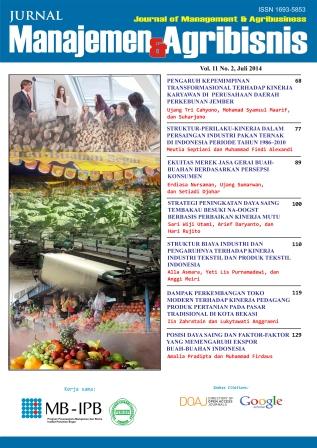POSISI DAYA SAING DAN FAKTOR-FAKTOR YANG MEMENGARUHI EKSPOR BUAH-BUAHAN INDONESIA
Abstract
The success of competitiveness of Indonesian fruits export in the destination countries is determined by comparative and competitive advantage and other factors. Revealed Comparative Advantage (RCA) and Export Product Dynamic (EPD) are used in this research to analyze the position of competitiveness of Indonesian fruits export. This research also uses panel gravity model to analyze the factors which affect the export volume of Indonesia fruits (mango, mangosteen, rambutan, banana, and melon). The results from EPD and RCA method show that fruits which have the highest comparative and competitive advantage in destination countries and the world are mangoesteen, mango, and guava. Indonesian fruit which lost its opportunity to compete in the destination countries is strawberry. The results of this research shows that the factors which influence the export of Indonesian fruits to the destination countries are export price, population, economic distance, real GDP and GDP per capita, real exchange rate, Indonesian consumer price index, and dummy variable of crisis which happened in Europe.
Keywords: competitiveness, EPD, gravity model, RCA
ABSTRAK
Keberhasilan daya saing ekspor buah Indonesia di negara tujuan ditentukan oleh keunggulan komparatif dan kompetitif serta faktor lainnya. Revealed Comparative Advantage (RCA) dan Export Product Dynamic (EPD) digunakan untuk menganalisis posisi daya saing ekspor buah-buahan Indonesia. Pada penelitian ini digunakan analisis data panel gravity model untuk menganalisis faktor-faktor yang memengaruhi aliran volume ekspor buah-buahan Indonesia (mangga, manggis, rambutan, pisang, dan melon). Pada metode Export Product Dynamic (EPD) dan Revealed Comparative Advantage (RCA) menunjukkan bahwa buah yang memiliki keunggulan komparatif dan kompetitif tertinggi di negara tujuan dan dunia adalah buah manggis, mangga, dan jambu. Ekspor buah Indonesia yang kehilangan kesempatan dalam bersaing di negara tujuan adalah stroberi. Hasil penelitian menunjukkan bahwa faktor yang memengaruhi aliran ekspor buah Indonesia ke negara tujuan meliputi harga ekspor, populasi, jarak ekonomi, GDP riil dan per kapita, nilai tukar riil, indeks harga konsumen Indonesia, dan variabel dummy krisis yang terjadi di Eropa.
Kata kunci : Daya saing, EPD, gravity model, RCA
Keywords: competitiveness, EPD, gravity model, RCA
ABSTRAK
Keberhasilan daya saing ekspor buah Indonesia di negara tujuan ditentukan oleh keunggulan komparatif dan kompetitif serta faktor lainnya. Revealed Comparative Advantage (RCA) dan Export Product Dynamic (EPD) digunakan untuk menganalisis posisi daya saing ekspor buah-buahan Indonesia. Pada penelitian ini digunakan analisis data panel gravity model untuk menganalisis faktor-faktor yang memengaruhi aliran volume ekspor buah-buahan Indonesia (mangga, manggis, rambutan, pisang, dan melon). Pada metode Export Product Dynamic (EPD) dan Revealed Comparative Advantage (RCA) menunjukkan bahwa buah yang memiliki keunggulan komparatif dan kompetitif tertinggi di negara tujuan dan dunia adalah buah manggis, mangga, dan jambu. Ekspor buah Indonesia yang kehilangan kesempatan dalam bersaing di negara tujuan adalah stroberi. Hasil penelitian menunjukkan bahwa faktor yang memengaruhi aliran ekspor buah Indonesia ke negara tujuan meliputi harga ekspor, populasi, jarak ekonomi, GDP riil dan per kapita, nilai tukar riil, indeks harga konsumen Indonesia, dan variabel dummy krisis yang terjadi di Eropa.
Kata kunci : Daya saing, EPD, gravity model, RCA
Authors
PradiptaA., & FirdausM. (2015). POSISI DAYA SAING DAN FAKTOR-FAKTOR YANG MEMENGARUHI EKSPOR BUAH-BUAHAN INDONESIA. Jurnal Manajemen Dan Agribisnis, 11(2), 129-143. https://doi.org/10.17358/jma.11.2.129-143
Authors who publish with this journal agree to the following terms:
- Authors retain copyright and grant the journal right of first publication with the work simultaneously licensed under a Creative Commons Attribution License that allows others to share the work with an acknowledgement of the work's authorship and initial publication in this journal.
- Authors are able to enter into separate, additional contractual arrangements for the non-exclusive distribution of the journal's published version of the work (e.g., post it to an institutional repository or publish it in a book), with an acknowledgement of its initial publication in this journal.
- Authors are permitted and encouraged to post their work online (e.g., in institutional repositories or on their website) prior to and during the submission process, as it can lead to productive exchanges, as well as earlier and greater citation of published work (See The Effect of Open Access).

